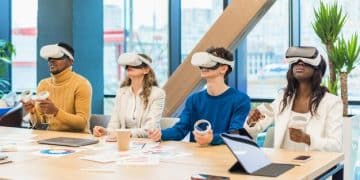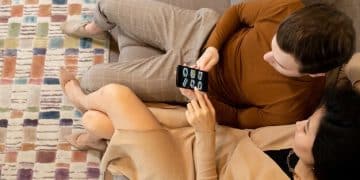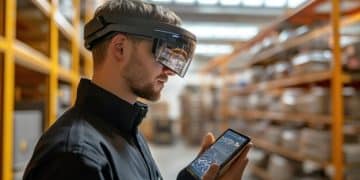Augmented Reality for Visually Impaired: New Accessibility Tools in 2025
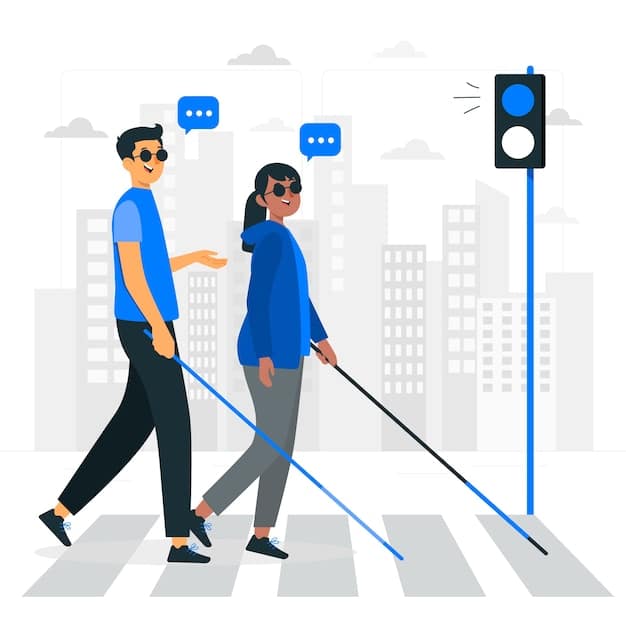
Augmented Reality (AR) is poised to revolutionize accessibility for visually impaired US citizens by 2025, offering innovative tools that enhance navigation, object recognition, and access to information, fostering greater independence and inclusion.
Augmented Reality and Accessibility: New Tools for Visually Impaired US Citizens in 2025 promises a future where technology bridges the gap for those with visual impairments, offering unprecedented levels of independence. Imagine a world where AR overlays provide real-time assistance, transforming everyday challenges into manageable tasks.
The Promise of Augmented Reality for Accessibility
Augmented Reality (AR) is rapidly evolving, and its potential to enhance accessibility for individuals with visual impairments is becoming increasingly clear. By overlaying digital information onto the real world, AR can provide crucial assistance with navigation, object recognition, and access to textual and visual data.
For visually impaired citizens in the US, AR represents a significant leap forward in assistive technology. With the expected advancements by 2025, AR tools are poised to become more sophisticated, user-friendly, and integrated into daily life.
Enhanced Navigation
One of the most promising applications of AR for the visually impaired is in navigation. Imagine AR glasses that can identify and highlight pedestrian crossings, obstacles, and points of interest in real-time.
This technology could provide auditory or haptic feedback to alert users to potential hazards and guide them safely through unfamiliar environments. The integration of GPS and mapping data would further enhance the accuracy and reliability of AR navigation systems.
- Real-time obstacle detection and avoidance
- Auditory and haptic feedback for navigation cues
- Integration with GPS and mapping data for accurate positioning
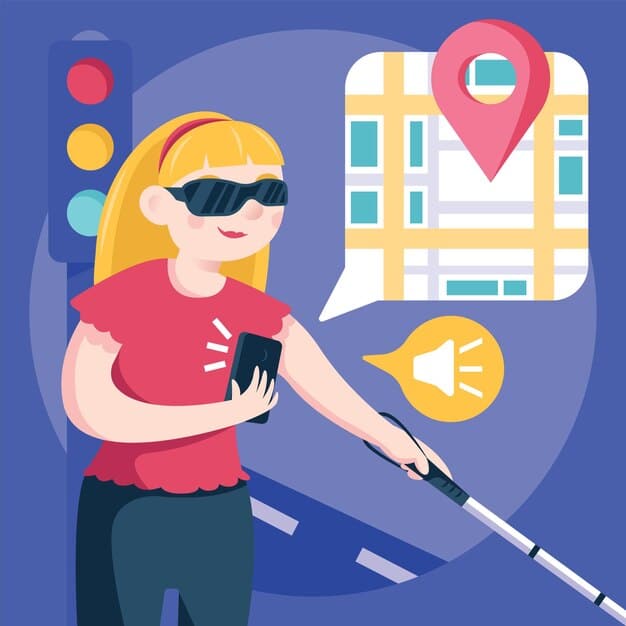
In conclusion, AR-enhanced navigation can provide visually impaired individuals with increased confidence and independence, enabling them to explore their surroundings with greater ease.
Object Recognition and Identification
Beyond navigation, AR can also be used to help visually impaired individuals identify and recognize objects in their environment. This capability can be particularly useful in a variety of everyday situations, from grocery shopping to managing medications.
By leveraging computer vision algorithms and machine learning, AR devices can quickly analyze the scene in front of the user and provide real-time information about the objects they encounter. This information can be delivered through auditory or tactile interfaces, ensuring accessibility for individuals with varying degrees of visual impairment.
AR for Daily Tasks
Consider the potential of AR to assist with tasks such as reading labels, identifying products, and organizing household items. With AR, visually impaired individuals can access information that would otherwise be difficult or impossible to obtain. For example, AR glasses could scan a can of soup and read out the ingredients and nutritional information.
This type of functionality can significantly improve the quality of life for visually impaired individuals, enabling them to participate more fully in daily activities and maintain their independence. As AR technology continues to advance, we can expect even more sophisticated object recognition capabilities to emerge.
- Real-time identification of objects and products
- Auditory and tactile feedback for information delivery
- Integration with databases for comprehensive product information
In summary, object recognition and identification through AR can empower visually impaired individuals to manage daily tasks with greater confidence and efficiency, fostering a sense of independence and self-reliance.
Accessing Information with AR
Another significant benefit of AR for the visually impaired is its ability to provide access to textual and visual information. This can include everything from reading books and newspapers to accessing digital documents and websites.
By using optical character recognition (OCR) technology and text-to-speech software, AR devices can convert written text into audible speech, allowing visually impaired individuals to “read” printed materials. Similarly, AR can be used to describe images and videos, providing users with a richer understanding of visual content.
Reading and Understanding
Imagine being able to point your AR glasses at a menu in a restaurant and have the menu items read aloud. Or being able to access the text of a book simply by pointing your AR device at the page. These are just a few examples of how AR can transform the way visually impaired individuals access and consume information.
Furthermore, AR can be used to enhance the accessibility of digital content. Websites and applications can be designed with AR overlays that provide alternative text descriptions for images, captions for videos, and other accessibility features. This ensures that visually impaired users have the same access to information as their sighted peers.
- Conversion of written text to audible speech
- Description of images and videos for enhanced understanding
- AR overlays for accessible digital content
In conclusion, AR provides visually impaired individuals with unprecedented access to information, enabling them to participate more fully in education, employment, and other aspects of life.
Social Inclusion and Interaction
Beyond practical assistance with daily tasks and information access, AR can also play a significant role in promoting social inclusion and interaction for visually impaired individuals. By enhancing their ability to navigate social situations and communicate effectively, AR can help break down barriers and foster a greater sense of belonging.
For example, AR glasses could be equipped with facial recognition technology that identifies the people around the user and provides their names and other relevant information. This can be particularly helpful in social gatherings or professional settings, where it can be difficult for visually impaired individuals to recognize and remember faces.
AR in Social Settings
AR can also be used to enhance communication by providing real-time translations of speech or sign language. This can facilitate interactions with individuals who speak different languages or use different modes of communication. As AR technology continues to evolve, we can expect to see even more innovative applications that promote social inclusion and interaction.
The use of AR in social settings can significantly improve the confidence and comfort levels of visually impaired individuals, enabling them to participate more fully in social activities and build meaningful relationships.
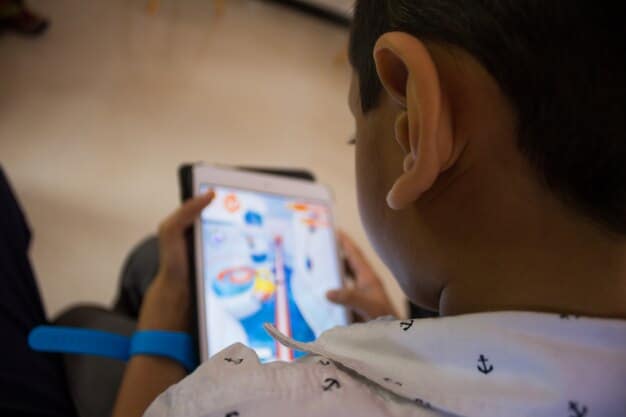
- Facial recognition technology for identifying people
- Real-time translations of speech and sign language
- Enhancement of social cues and contextual awareness
In summary, AR can be a powerful tool for promoting social inclusion and interaction, helping visually impaired individuals connect with others and participate more fully in their communities.
Challenges and Considerations for AR Adoption
While the potential benefits of AR for visually impaired US citizens are enormous, there are also several challenges and considerations that must be addressed to ensure its successful adoption and widespread use. These include technological limitations, cost and affordability, user training and support, and ethical considerations.
One of the main technological challenges is the need for AR devices to be lightweight, comfortable, and energy-efficient. Users will be wearing these devices for extended periods of time, so it is essential that they are not cumbersome or uncomfortable. Additionally, AR devices must be able to operate reliably in a variety of lighting conditions and environments.
Overcoming Obstacles
Cost is another significant barrier to adoption. AR devices can be expensive, and many visually impaired individuals may not be able to afford them. It is important that government agencies, non-profit organizations, and technology companies work together to develop affordable AR solutions for the visually impaired.
Furthermore, user training and support are essential to ensure that visually impaired individuals are able to effectively use AR technology. Training programs should be designed to address the specific needs and challenges of visually impaired users, and ongoing technical support should be readily available.
- Addressing technological limitations (weight, comfort, energy efficiency)
- Ensuring affordability and accessibility
- Providing comprehensive user training and support
In conclusion, by addressing these challenges and considerations, we can pave the way for the widespread adoption of AR technology and unlock its full potential to improve the lives of visually impaired US citizens.
The Future of AR Accessibility in 2025 and Beyond
Looking ahead to 2025 and beyond, the future of AR accessibility for visually impaired US citizens is bright. With continued advancements in technology, increased awareness and advocacy, and collaborative efforts from stakeholders, AR is poised to transform the lives of visually impaired individuals in profound ways.
We can expect to see AR devices become more integrated into daily life, with seamless connectivity to other devices and services. AR applications will become more sophisticated and personalized, adapting to the individual needs and preferences of each user.
Continued Innovation
Furthermore, we can anticipate the emergence of new AR applications that address a wider range of accessibility challenges. This could include AR-based tools for education, employment, recreation, and healthcare. As AR technology becomes more ubiquitous, it will create new opportunities for visually impaired individuals to participate fully in society.
In conclusion, the future of AR accessibility is full of promise. By embracing innovation, fostering collaboration, and prioritizing the needs of visually impaired users, we can create a world where technology empowers individuals to live more independent, fulfilling, and connected lives.
- Increased integration of AR devices into daily life
- Development of more sophisticated and personalized AR applications
- Expansion of AR applications to address a wider range of accessibility challenges
| Key Point | Brief Description |
|---|---|
| 🗺️ Navigation | AR provides real-time guidance, obstacle detection, and enhanced GPS for safer mobility. |
| 👓 Object Recognition | AR identifies objects and products to aid daily tasks like shopping and medication management. |
| 📚 Information Access | AR converts text to speech and describes images, enabling access to digital and printed information. |
| 🤝 Social Inclusion | AR enhances social interactions by providing facial recognition and real-time communication assistance. |
FAQ
▼
AR can overlay digital information onto the real world, highlighting crosswalks, obstacles, and points of interest. This provides auditory or haptic feedback to guide users safely.
▼
AR can help with reading labels, identifying products, and organizing household items. For example, AR glasses could scan a can of soup and read the ingredients aloud.
▼
AR uses OCR technology and text-to-speech software to convert written text into audible speech. It also describes images and videos to enhance understanding of visual content.
▼
AR can use facial recognition to identify people and provide their names, helping visually impaired individuals navigate social interactions. It can also provide real-time translations.
▼
Challenges include technological limitations like weight and energy efficiency, the cost of AR devices, the need for user training, and ethical considerations related to data privacy.
Conclusion
In conclusion, Augmented Reality and Accessibility: New Tools for Visually Impaired US Citizens in 2025 offers transformative possibilities. By addressing current challenges and fostering continued innovation, AR can significantly enhance the independence, social inclusion, and overall quality of life for visually impaired individuals in the United States.

